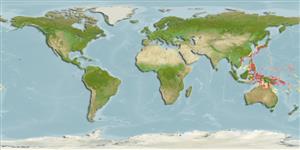Classification / Names
Common names from other countries
Main reference
Size / Weight / Age
Max length : 11.0 cm SL male/unsexed; (Ref. 48637); 6.1 cm SL (female)
Environment
Marine; demersal; depth range 12 - 35 m (Ref. 90102)
Climate / Range
Subtropical, preferred ?
Distribution
Southwest Pacific: Okinawa-jima, Ryukyu Islands, Okinawa Prefecture (Japan).
Countries | FAO areas | Ecosystems | Occurrences | Introductions
Short description
Dorsal
spines
(total): 7;
Dorsal
soft rays
(total): 13;
Anal
spines: 1;
Anal
soft rays: 13. Characterized by pale grey color; ventral surface of body whitish; four brown bars on body; head with irregular brown reticulations and in pale spaces between bars; brown bar across operculum; narrow brown bar under eye; narrow brown band behind eye; head with scattered blue spots/streaks; pelvic fins united by low membrane at base of fins; without median predorsal scales; side of nape with scales extending forward above middle of opercle; longitudinal scale series 92-97; greatest depth of body 7.1-8.5 in SL; lanceolate caudal fin, longer than head length (Ref. 90102).
IUCN Red List Status (Ref. 115185)
Threat to humans
Harmless
Human uses
More information
Common namesSynonymsMetabolismPredatorsEcotoxicologyReproductionMaturitySpawningFecundityEggsEgg development
Age/SizeGrowthLength-weightLength-lengthLength-frequenciesMorphometricsMorphologyLarvaeLarval dynamicsRecruitmentAbundance
ReferencesAquacultureAquaculture profileStrainsGeneticsAllele frequenciesHeritabilityDiseasesProcessingMass conversion
Tools
Special reports
Download XML
Internet sources
Estimates of some properties based on models
Phylogenetic diversity index
PD50 = 0.5000 many relatives (e.g. carps) 0.5 - 2.0 few relatives (e.g. lungfishes)
Trophic Level
3.4 ±0.3 se; Based on size and trophs of closest relatives
Resilience
High, minimum population doubling time less than 15 months (Preliminary K or Fecundity.)
Vulnerability
Low to moderate vulnerability (27 of 100)
Price category
